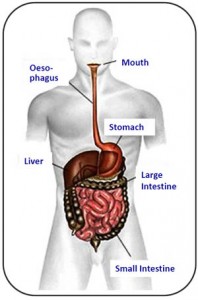Dartsch Digestive Tract Model
- Static and, thus, comprehensible simulation of the physiological conditions of the human gastrointestinal tract
- Total digestion as well as single digestive steps
- High variability of digestive conditions possible (e.g. fasting and fed conditions, use of a high fat diet according to FDA is possible)
- Free of individual variations as present in experimental animals or human volunteers
- Use in very early stages of development helps to reduce total development periods and costs
- Examination of beneficial and/or unwanted toxic (side) effects
- Only a limited amount of sample material is needed (about 1 to 2 g)
- No ethical and time-consuming limitations as usual for animal or volunteer clinical experiments
- Quick results within some working days
Main compartments of the Dartsch Digestive Tract Model
 Mouth -> Synthetic saliva
Mouth -> Synthetic saliva
Inorganic components: NaCl, NaSCN, KCl, Na2SO4, NaHCO3, KH2PO4, CaCl2
Organic components: urea, uric acid, mucin from porcine pancreas, alpha-amylase
pH-value: 5,6
Extraction time: variable (up to several min at 37 °C)- Stomach -> Synthetic gastric juice
Inorganic components: NaCl, KCl, KH2PO4, HCI
Organic components: pepsin from porcine gastric mucosa, mucin from porcine pancreas
pH-value: 1.8 (fasting) to 6.0 (fed conditions)
Extraction time: variable (up to 8 h at 37 °C)
- Small Intestine -> Synthetic intestinal juice
Inorganic components: KCl, CaCl2, MgCl2, NaHCO3
Organic components: trypsin from bovine pancreas, pancreatin from porcine pancreas, porcine bile extract, lipase from porcine pancreas
pH-value: 5.8 to 7.6
Extraction time: variable (up to 16 h at 37 °C)
- Liver -> primary metabolization (first pass effect)
We use cookies to ensure that we give you the best experience on our website. If you continue to use this site we will assume that you confirm it. / Wir verwenden Cookies, um die Qualität und Benutzerfreundlichkeit der Webseite zu verbessern und Ihnen einen besseren Service zu bieten. Wenn Sie auf "Ok" klicken, erklären Sie sich damit einverstanden.OkRead more / Weiterlesen
 Mouth -> Synthetic saliva
Mouth -> Synthetic saliva


